Visiting a winery is a fun, social way to learn about a wine region and try wines from your favorite producers, including winery-exclusive selections only available on-site. The experience can be intimidating for first-time tasters unfamiliar with winery protocols. Some wineries are casual and laid-back, while others are exclusive and luxurious.
However, remember that all wineries begin with the same foundation: a dedication to crafting something delicious by combining art, science, agriculture, and alcohol. You should feel that passion during your day of tasting. The best way to ensure the experience is pleasurable is by planning.
As a sommelier and wine writer, I have spent the past two decades visiting wineries worldwide. Taking note of my experiences led us to create this guide with everything you need to know when visiting a winery. By following these suggestions, you will be ready to swirl, sniff, and sip your way through a day of winery visits. Happy tasting.
Make a reservation
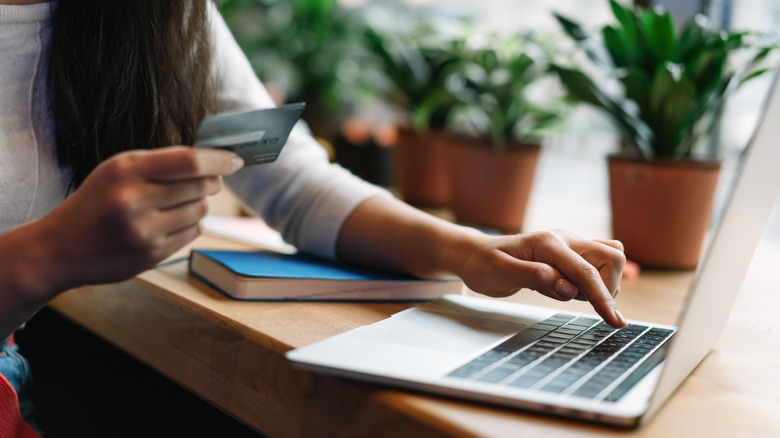
There was a time in our not-too-distant past when you could easily walk into a winery tasting room without a reservation and taste through a selection of current-release wines. This was often done inexpensively, and sometimes with the winery’s owner. Sadly, those days are gone. Though you can still find some wineries open to guests without a reservation, for the most part, advance bookings are either required or highly recommended.
Closures during the coronavirus pandemic forced many wineries to rethink their business model, introducing specialized seated tastings that cater to smaller numbers of guests. Requiring a prior reservation also helps winery staff prepare for the amount of visitors they are expecting on any given day. This practice translates to a better wine tasting session for you, as proper staffing ensures you have the best experience possible.
We suggest you research the wineries in the area you would like to visit. Review the experiences offered and find the tasting that fits your style, which may include a vineyard tour, cave tasting, or wine and food pairing. Being prepared is always best, especially if you’re bringing a larger group.
Schedule plenty of time at each winery

As you begin to plan your wine tasting itinerary, figure out how many wineries you want to visit. We recommend limiting the number to three or four visits per day so as not to feel rushed to get to the next appointment.
Most tastings will last around an hour to an hour and a half, depending upon your group size and the type of experience you book. As you plan, you will want to schedule time for lunch, or book a tasting that includes a wine and food pairing. Remember to calculate how long it will take to drive from one stop to the next.
Punctuality for your appointments is also important. A winery’s schedule can be tight, especially on weekends. Arrive at your appointments on time, and call to notify the winery if you are running late.
Designate or hire a driver
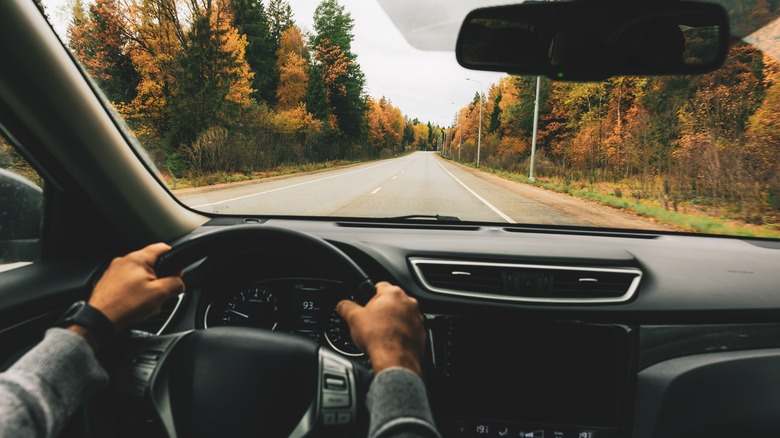
Whether you designate a driver or hire a car service, ensuring that you do not drink and drive is essential for any wine tasting tour. Luckily, driver services are readily available in most wine regions. Finding the right one is just a Google search away.
Many wine-country transportation firms also offer concierge services to help plan your itinerary and book reservations, which can be useful for anyone unfamiliar with the region’s wineries. However, if you have preferences, it is entirely appropriate to ask the concierge to include those wineries, or make bookings yourself.
If you choose to designate a driver from your group who will attend tasting experiences, like visiting a vineyard or taking a wine-cave tour, make sure to ask if there are charges for guests who won’t be tasting. It also may be tempting to use a ride-hailing service like Uber or Lyft. We don’t recommend relying on this service. Their availability is limited, which is problematic when you’re trying to get to your next appointment.
Be prepared for the costs
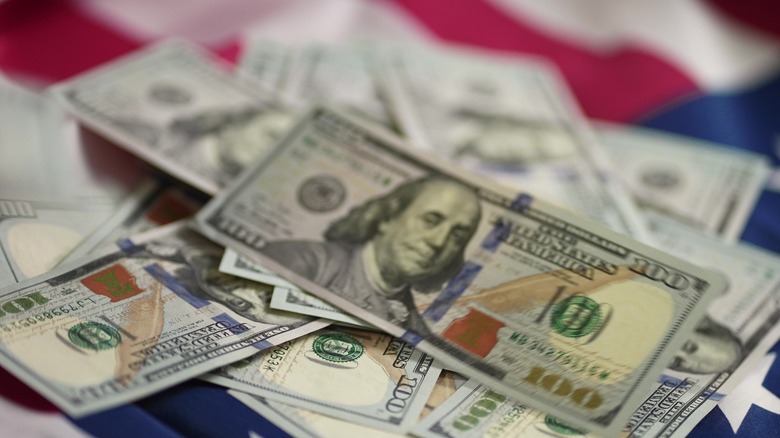
ibragimova/Shutterstock
Similarly to how tasting at a winery without an appointment is largely gone, tastings that are free or with a nominal fee are rare. Today, most wineries charge a fee to taste with them, and those fees are soaring, especially in popular wine regions like Napa and Sonoma. According to the SVB 2023 Direct-to-Consumer Wine Survey, the average cost of a standard wine tasting in Napa Valley is now $81, while in 2012 Napa’s average tasting fee was $22. Fees in wine regions like Santa Barbara, Paso Robles, and Willamette Valley can also be high.
Preparing for the cost will ensure that you enjoy the winery experience thoroughly. Booking your appointments beforehand will allow you to familiarize yourself with the wine prices and tasting fees. Some wineries may waive the fee for the tasting if you buy a few bottles, but this practice is less common today than in years past. And don’t be afraid to share a tasting with your partner, both to save money and pace yourself.
Dress comfortably

Comfort is vital to enjoying a winery visit. Leave your favorite evening stilettos at home. There is no place for high heels in wine country. Sure, you want to look stylish, but this is not a formal night out. Instead, opt for chic wine-country-casual clothing. We recommend comfortable shoes, like flats, boots, or sandals, lending ease when walking on winery tours. If you plan on doing a vineyard tour, closed-toe shoes are best.
Loose, comfortable clothing — like sundresses for women, and shorts or khakis with a collared shirt for men — are appropriate for daytime tastings. A cross-body bag will hold all of your daily essentials. And remember to bring a hat, sunglasses, and sunscreen for outdoor winery tours. Bring along a jacket as well for indoor cave tastings, as wine cellars are chilly. Lastly, we recommend wearing darker colors, in case accidental spills occur.
Don’t wear fragrances or perfumed lotion
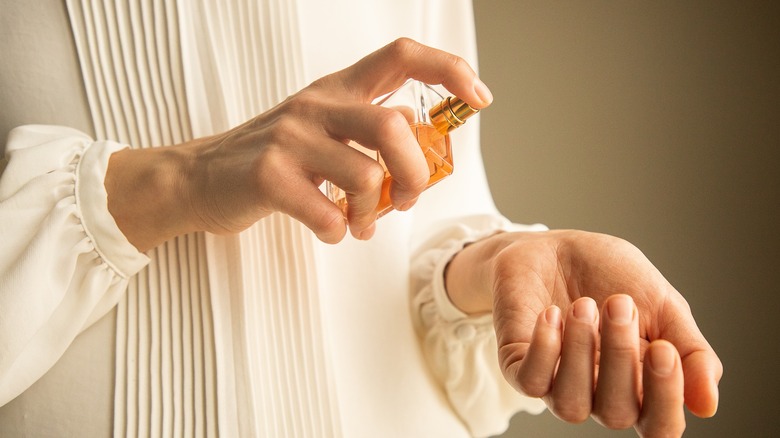
As you dress for your day of wine tasting, skip the spritz of perfume or cologne, as fragrances interfere with the sensory experience of a wine tasting. One of the most significant components of enjoying a glass of wine is the aroma and the bouquet. The subtle nuances found in these wine components offer information about what is in the glass.
The aroma can help you identify the different types of grapes used and the vineyard terroir. At the same time, the bouquet lends details on the winemaking techniques and the aging process, like the type of oak used to barrel-age the wine and the fermentation practices employed. Wearing a fragrance can mask these characteristics. Strong fragrances will also compromise the tasting experience of other winery guests, reflecting poor wine tasting etiquette.
Understand the winery’s policy regarding kids

Wineries are businesses that aim to sell you wine. Their goal to achieve this has led many wineries to create family-friendly experiences, including play areas for kids, tasting opportunities that include picnic areas, and vineyard tours. While many wineries are kid-friendly, some are not. Make sure you understand the winery’s policy before arriving with your children.
Bringing a child to a winery can be tricky, as not everyone attending a tasting will want to be around kids. If your children accompany you to a winery, keep a close eye on them. We suggest bringing along games or books to keep them entertained, and have them keep their voices down to ensure they don’t interrupt other guests.
And remember, guests enjoy alcoholic beverages at a winery. Though the atmosphere is different from a bar, it is still a place serving alcohol. Keep this in mind if you decide to bring children along.
Eat something light and pace yourself
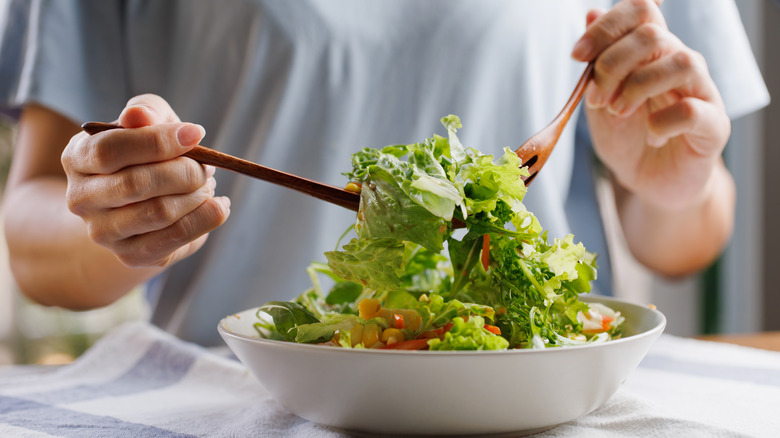
A day of wine tasting is a delightful, educational, social occasion. It is also a day of drinking. Even if you spit, you will likely ingest some wine. We suggest that you don’t go wine tasting on an empty stomach. Prepare by eating something light beforehand. However, avoid heavily flavored or spicy foods before tasting, as they can remain on your palate, like garlic, peppers, or coffee. Avoid smoking before tasting, as the tobacco will linger on your palate and in your clothes.
Throughout your day, it is also important to pace yourself. A day of wine tasting is a marathon, not a sprint. You don’t want to overdo it by getting buzzed at your first stop. Sip slowly, taking the time to enjoy the experience and evaluate the wines. And drink lots of water to stay hydrated.
Taste from light to heavy

A typical wine tasting will include a set number of wines laid out in order of how the winery would like for you to taste them. However, some establishments will offer the ability to customize the tasting with your preferred selections. With either option, it is best to taste starting from the lower-alcohol, lightest-bodied offerings to the heaviest, fullest-bodied wines.
The alcohol in the wine contributes to the weight. If you were to begin the tasting with a high-alcohol, full-bodied red wine, it would overwhelm your palate, causing you to miss the nuances found in lighter, lower-alcohol wines. Start the tasting with white wines before moving into robust reds. If you only taste white wines, begin with crisp, refreshing selections like a riesling before moving to rich, well-rounded chardonnay. For red-wine tasters, start with a high-acid, medium-bodied red like barbera or pinot noir before trying a bold, high-alcohol zinfandel.
Know the steps of tasting

With your wines laid out in a proper order, you are ready to begin your tasting. However, you may be wondering what to do. There are several steps to wine tasting, each of which will engage your senses. The first step is to observe the color and appearance of the wine by holding the glass by the stem up to the light, or against a piece of white paper. For a white wine, is it light yellow or more golden? For a red, is it the color of rubies or more inky and black? Is the wine cloudy or clear?
The second step is to smell the wine, keeping your mouth closed and breathing in the aromas deeply. What type of fruits or spices can you smell? Then, swirl the wine carefully in the glass and smell the wine again. Did any new aromas emerge? These steps are the right way to smell wine at a tasting, priming the palate for the flavors it can expect to find in the glass.
Next, sip the wine and savor its flavors. Evaluate what you like or dislike about the wine. It is also wholly appropriate to spit out the wine at a wine tasting to ensure you don’t become inebriated. Your tasting attendant will provide a vessel to use for this.
What to look for in a glass of wine

First and foremost, the only thing that matters when tasting a wine is if you like it. There are no right or wrong answers, as much of the experience is sensorial. Finding a wine that you find favorable and would like to know more about is most important.
Opening your palate and mind to exploring the variations within a grape variety will make your time more fun. Try to identify characteristics in the wine. Identifying flavors is not meant to be stressful, only to enhance your experience.
For example, once you try a wine, observe if it is dry or sweet. Does it taste tangy, like a sour lemon, or fruity, like an apple or pear? Does the wine taste spicy, smoky, or earthy? Is it filled with flavors of toast, chocolate, or vanilla? Does the wine feel heavy or high in alcohol? Which of these characteristics appeals to you? Answering these questions will help ascertain the style of wines you prefer.
Cleanse your palate

During your wine tasting, the attendant will likely share information about each of the wines, including various winemaking techniques, aromas, and flavors found within the wine. Give yourself the best chance at identifying these characteristics by making sure to always cleanse your palate between sips of each different wine.
The palate cleanser should be clean and refreshing, leaving no aftertaste so as to allow complete revelation of the next wine’s full flavor. Take a sip of room-temperature water, or eat a bite of cheese or a cracker between each selection. Water neutralizes the palate, cheese will help absorb tannins, and starchy bread and crackers will balance the palate by absorbing the previous wine’s flavors. By doing this, you can identify and enjoy each wine’s subtle characteristics.
Try something new
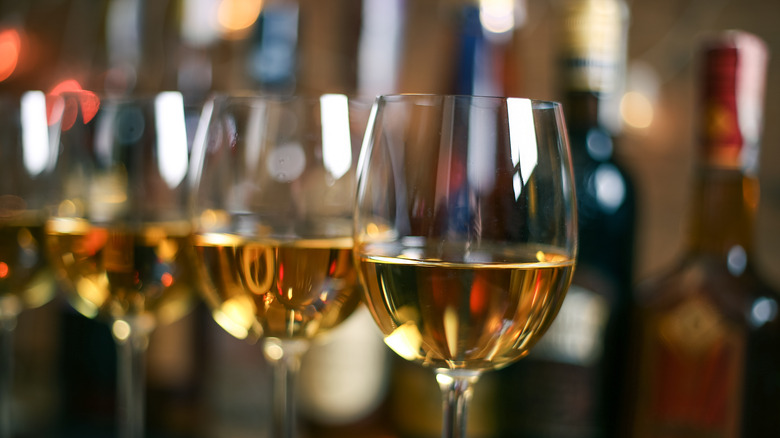
A typical wine flight, or set of wine pours measuring 2 or 3 ounces each, will be offered at each winery you visit. This flight often includes the winery’s current releases, library vintage selections, or other unique offerings. Each of these selections may consist of grape varieties that are new to you, or outside of the typical types of wines you drink.
Though you may be the type of person who refuses to drink a glass of chardonnay or only drinks pinot noir, a wine tasting is an opportunity to branch away from what you usually drink to taste something you otherwise wouldn’t. There is no rule saying you have to finish each of the wines poured for you. Go into the experience with an open mind, giving each selection a try. You may be pleasantly surprised.
Rinse with wine

If your tasting includes only one glass for trying all the wines, you may want to rinse the glass between tastings. Though you may be inclined to use water to clean the glass, we recommend you use wine. Water has the potential to mute and water down the upcoming wine, as some residual droplets may remain in the glass after rinsing.
Instead, ask the winery attendant to rinse your glass between tastes with a splash of the next wine. Any attendant should be open to doing this, because it will make sure that the wine is accurately represented. This is the reason fancy restaurants prime your wine glass before filling it. Swirl that splash of wine in your glass and pour it out. Your glass is now ready to enjoy the next wine in the tasting flight.
Ask questions and take notes

Il21/Getty Images
The biggest mistake you can make when tasting wine is to not enjoy the experience. However, there are ways to make your winery time more enjoyable, mainly by asking questions about the wine, winery, and region. The reason so many winemakers got into the business is that they have a passion for wine and its production. Every member of the winery’s team understands this passion and is there to relay it to you. Ask questions to learn the story of the wines, its producer, the wine region, and the terroir.
Most wineries will offer a tasting card listing the wines you will taste. This is for you to take notes about the winery, as well as to keep track of your favorite selections. Asking questions and taking notes will help you better appreciate the experience, and have a record of your likes and dislikes for the future.
Be respectful

DavideAngelini/Shutterstock
Consider that when you walk into a winery, you are walking into the home of the winemaker or owner. It is similar to when a restaurateur opens the door of their eatery to you. This place represents their life’s work. Your behavior in a winery should be identical to that expected at any other professional business, even though the atmosphere may be relaxed and casual.
Wine tastings are typically slowly-paced to give guests proper time to sip, savor, and evaluate each wine while enjoying the social experience. Be respectful of not only those in your group, but also your tasting attendant and others at the winery. Silence your cell phone, use your indoor voice, and don’t rush the tasting.
Of course, you can give your opinions on a glass of wine. However, please don’t act like you know more about it than the winemaker. Be open to exploration and learning something new. And remember that others want to have an enjoyable, memorable experience, just like you.
Tip your server
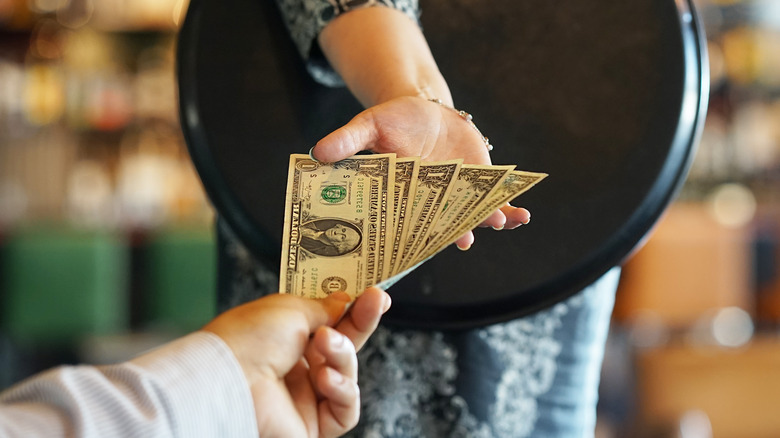
lunopark/Shutterstock
At the core of any wine tasting experience, the goal is to educate you about the wines and, hopefully, sell you a few bottles. Wineries do this by hiring and training their tasting room attendants to deliver their stories while providing high-quality service to you and your guests. While in the past there has been some question of whether or not you should tip your wine attendant, today it is considered appropriate.
The tip amount is up to you, similarly to how you would tip a server in a restaurant. Suppose you feel the attendant gave exemplary service and made your experience enjoyable. In that case, a 20% gratuity on the amount of the tasting is appropriate. Some wineries will include the gratuity automatically when you book your appointment, so check your transaction details before arriving at the winery.
Purchasing is an option, not a requirement

Alvarez/Getty Images
When wineries first started opening their doors to guests for wine tastings, it was to introduce their wines to customers and, hopefully, sell a few bottles. Today, wine tastings have become much more elaborate, immersive, and highly educational. However, wineries still host wine tastings to sell wine.
Nonetheless, there is never a requirement for a guest to buy the wines they have tasted. If you find something special, buy a few bottles. If you loved every element of the tasting and each wine poured, consider joining the wine club to enjoy discounts and annual winery events. However, this is optional.
If you are tasting on a hot day and expect to buy during your winery visits, pack a cooler with ice in your car to hold your bottles. This will ensure that your purchases will not cook in the trunk during your trip.







